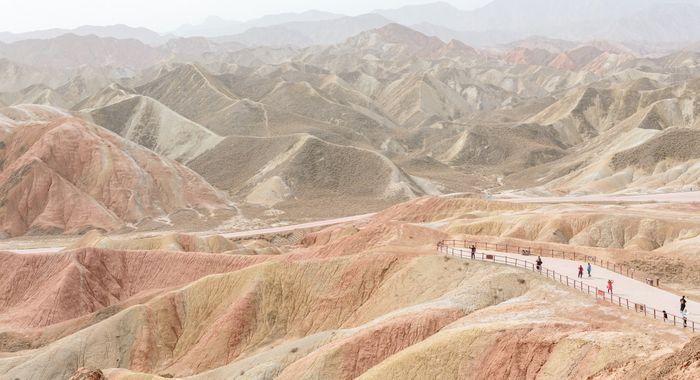Journalism // Long Day's Journey Into Night (SUITCASE Magazine Vol. 25)
I organised a trip to the Norwegian archipelago of Svalbard for a polar safari on the cusp between summer and winter, looking into how its legacy of pioneers is being translated for a conservation-minded new generation of travellers and locals. Alongside the photographer Benjamin Hardman, I visited the world's northernmost town of Longyearbyen, met off-duty huskies, took a freezing RIB-boat ride across the waters to the converted radio station Isjford Radio Hotel and hiked out to spot glaciers and fat, lazy walruses. The final article was published in the winter 2018 issue of SUITCASE Magazine, The Pioneer Issue. You can read an extract of the piece here: https://suitcasemag.com/articles/norway-svalbard-archipelago-photo-journal
I skitter and stumble my way across the pebbly plain, trying to avoid stepping on the bursts of mustard-coloured moss that have somehow sprouted in this most inhospitable of places. Triangular peaks as rigid as the arms of a compass puncture an endlessly blank sky, while the gargantuan slopes of their elders yawn down to the blasted earth below.
Acres of shale stretch out before me, broken only by fragments of whale bone and the brackish sea surging to my right. The sheer scale of it all means that time and distance both dissipate – as soon as I pause to catch my breath the mountains recede and loom all at once, a magic-eye pattern whirling against the wind. Mars would be too cheap an analogy for this sense of weightlessness, of being untethered from my very self. Purgatory might be better.
Svalbard is a land of both extremes and in-betweens. The archipelago is situated between 74 and 81 north, nearly a thousand miles from the Norwegian mainland and at the very end of the earth. From April to August it is bleached in eternal daylight and from the close of October until February it plunges into perpetual darkness. Centuries of explorers, hunters and miners have variously tried (and sometimes failed) to conquer its soaring shores, and both blood and blubber mingle in their tales of dominion and disaster.
Yet there is nuance hidden between Svalbard’s theatrical landscapes and legends. Humanity is a relatively recent intervention here and consequently there is no framework of culture, art or ancient history from which to hang my impressions. It is a place of passage rather than of permanence – it is literally forbidden by law to be born or to die here, as there are no hospitals or burial grounds – and its monochromatic vistas with their slate-grey seas, powdery mountains and smudges of cloud suggest a withholding, as well as perhaps an invitation. It’s a place that can make or break you, and consequently an intoxicating challenge to the pioneer spirit.
The practice of trapping, whereby hunters would live largely in isolation in the wilderness to gather and sell the pelts of Arctic foxes and polar bears, peaked in the early 1900s. Today there are only three trappers left on the archipelago, the hunting of polar bears is strictly forbidden and the dogs at the Trapper’s Station are used for the purposes of sledding only.
In homage to the islands’ history the station has been designed with two replica cabins where guests can sleep over if they choose, alongside gruesome relics of the trapper lifestyle such as a seal post, where seal carcasses were strung up to escape the clutches of hungry polar bears, and a shotgun trap formerly used to “humanely” kill the bears. I’m more enchanted by the dozens of yelping dogs with curious names – Instagram and Twitter, Odin and Lyra, and Eminem, ever the outcast, in the middle – who leap up until their paws rest on my shoulders and their piercing blue eyes bore into mine.
There are candles flickering on every windowsill, an abundance of fluffy cushions and throws and, most surprisingly, a nightly five-course feast of slow food. There’s a tendency towards pickled and fermented dishes as well as reindeer provided by one of Svalbard’s few remaining trappers, Tommy Sandal, who lives in a cabin with his dogs and has hunted here for over 15 years.
We eat fresh sourdough, smoked mackerel mousse, grilled Arctic cod and reindeer every which way before the conversation turns to the unpredictability of ice and whether the Northern Lights can sing. It’s easy to forget how far into the wilderness we are until we’re shown a scuffed and scratched bottle of red wine, a souvenir from the time a few months ago when a polar bear broke into the storage room and mauled its contents before trying to escape through a window.
After a heavy night’s sleep induced by too much cava, we embark on a hike across the broad, flat plain to try and spot a walrus colony, hoping that they won’t yet have departed for the season. Led by our guide Ivar and retired husky Borneo, I lose track of how long we spend crunching over ice and stone, the confronting scale shrinking me to Lilliputian dimensions while giving my thoughts space to roam. We eventually reach a dilapidated shipwreck of a cabin – which I’m told would have been a kind of bleak “holiday home” for those at the station needing a break from their colleagues – beyond which a group of 30 or so walruses are huddled together on the shoreline.
We creep towards them while maintaining a respectable distance so as not to disturb them and I forget the slow freezing of my fingers as I watch them roll languorously on to their backs, rear their spindly tusks and effortfully heave themselves into the sea. Such a colony would once have been easy prey for hunters, who would spear the slow-moving land creatures before they could escape into the waves, but today Svalbard’s status as a certified Sustainable Destination means that the only capture they risk is through a camera lens. On our way back, we stumble across a small herd of curious reindeer, who with their shaggy winter coats, stocky legs and doleful expressions look rather like white pigs. As with the walruses, it’s a shock to encounter wildlife thriving among so much emptiness and I wonder how they survive.
As we ride the final few kilometres into Longyearbyen the first snow of the season starts to fall thick and fast, and by the time we draw in the whole town is blanketed in a layer of white. It appears that winter has arrived just as I’m due to depart. I haven’t seen polar bears, whales or the Northern Lights – in many ways, I haven’t seen much at all beyond the harsh purity of the landscape – but Svalbard is a place that refutes tick-box tourism. Instead, what I witnessed here was my own insignificance against its age-old vistas, as well as a new community of pioneers dedicated to forging a future based on sustainable tourism rather than exploitation.
Although I can’t help but roll my eyes when Ben, who stays on a few days longer, excitedly texts me his pictures of his encounters with polar bears and Arctic foxes, I have to accept that Svalbard is a study in patience and letting the land reveal its secrets at its own pace. As Christiane Ritter, a writer who lived in a cabin here in the 1930s, wondered: “Perhaps in the future, man will go into the Arctic in the same way as in Biblical times, man journeyed into the desert in search of the truth”.

